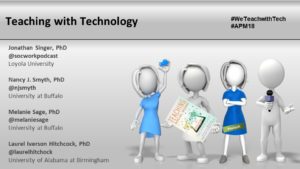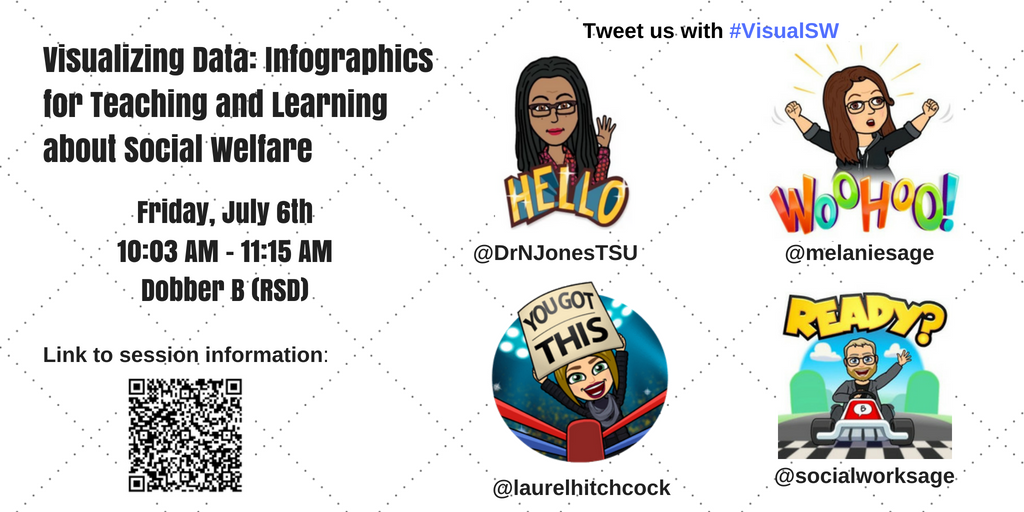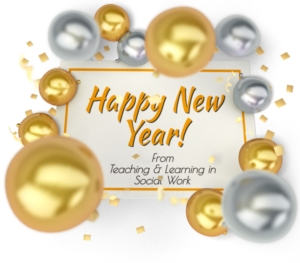Review of Teaching & Learning in Social Work for 2018
One of the reasons I like a good “end-of-the-year list” is the opportunity to reflect on what I did and did not miss out on over the past year. I’m always thrilled to discover I read one or maybe even two of the most notable books on the New York Times yearly list. Then, I start planning my reading wish list for the coming year, which usually involves magical thinking about reading every winner of the Nobel Prize for Literature or the all the Pulitzer Prize winners for Non-Fiction from the last ten years. Even if I don’t actually read all of these books, I believe in having some goals for my reading and other activities. For the Teaching and Learning in Social Work Blog, I had three goals for 2018:
1 .Write or publish 30 blog posts
2. Increase the number of blog subscribers from 100 to 200
3. Publish 10 guest educator blog posts
Here is how those goals worked out:
1. Wrote only 13 blog posts during the year, but published a total of 21 posts (70% completed)
2. Only added 40 more subscribers to the blog (40% completed)
3. Published 8 guest educators posts (80% completed)
While not all my goals were achieved, I was still able to collaborate with others to accomplish some solid writing for the blog including information about projects that I have been working on, and all my conference presentations for the year. Below is a list of this year’s posts, grouped around the topics of projects, guest educator posts, and conference presentations.
Projects: These posts describe new projects that I started or worked on during 2018:
#APM18 Teaching with Technology using the SAMR Model
 On Thursday, November 8, 2018, I will be presenting with Jonathan Singer, Melanie Sage & Nancy J. Smyth the Teaching Institute for Early Career Faculty at the Council on Social Work Education’s 2018 Annual Program Meeting. In this session, we are focusing on how faculty can incorporate technology into a social work course. All educators, especially those early in their careers, find themselves teaching from syllabi they had no role in developing. Although there are many benefits to the “hand-me-down” syllabus, one of the limitations is that assignments are rarely updated to reflect the realities of the 21st century workplace, which now includes the use of technology to achieve practice outcomes for clients and organizations. The purpose of this workshop is to learn about how to incorporate the use technology into a social work assignment on your syllabus, using Puentedura’s SAMR Module for Technology Integration. We will provide a brief overview of teaching with technology before focusing on how to infuse technology into an assignment from your syllabus, including learning objectives and associated assessment techniques in your syllabus. Participants will learn to identify ways to substitute, augment, modify or redefine existing learning strategies and assignments with technology-mediated learning strategies and assignments. By the end of the session, the participant will have an assignment that uses technology to meet the learning needs identified in the syllabus.
On Thursday, November 8, 2018, I will be presenting with Jonathan Singer, Melanie Sage & Nancy J. Smyth the Teaching Institute for Early Career Faculty at the Council on Social Work Education’s 2018 Annual Program Meeting. In this session, we are focusing on how faculty can incorporate technology into a social work course. All educators, especially those early in their careers, find themselves teaching from syllabi they had no role in developing. Although there are many benefits to the “hand-me-down” syllabus, one of the limitations is that assignments are rarely updated to reflect the realities of the 21st century workplace, which now includes the use of technology to achieve practice outcomes for clients and organizations. The purpose of this workshop is to learn about how to incorporate the use technology into a social work assignment on your syllabus, using Puentedura’s SAMR Module for Technology Integration. We will provide a brief overview of teaching with technology before focusing on how to infuse technology into an assignment from your syllabus, including learning objectives and associated assessment techniques in your syllabus. Participants will learn to identify ways to substitute, augment, modify or redefine existing learning strategies and assignments with technology-mediated learning strategies and assignments. By the end of the session, the participant will have an assignment that uses technology to meet the learning needs identified in the syllabus.
#husITa18/#SWSD2018: Sustaining lifelong learning through the use of Technology-Mediated Professional Learning Networks
On Friday July 6, 2018 at 3:15 PM in the Exhibition Hall at the 2018 International Social Work, Education & Social Development Conference, Melanie Sage, Nancy J. Smyth, Jonathan Singer, and I are presenting a poster about how social workers can use technology for career-long learning, specifically by creating a Professional Learning Network (PLN).
Simply stated, PLNs employ, within an online environment, the same strategy that social work professionals have used for centuries: the practice of connecting to people who share interests and can learn from each other. PLNs are a well-established practice in the field of education (Richardson & Manacebelli, 2011). The term comes from the educational technology learning communities and has its origins in Connectivism, a learning theory developed by George Siemens (2005) to explain how network-based learning occurs in the digital age. Specifically, Connectivism suggests that learning is the process of connecting sources of information together across networks, shifting learning from an individual process to a community effort. Thus, learning includes the skills of managing the flow of information, determining what is and is not useful information, and maintaining connections with others to facilitate on-going learning (Siemens, 2005). All of these skills are developed and applied with a PLN.
We are all big fans of PLNs, and have been sharing the practice with the social work community in the US for over a year now. Nancy, Melanie and I introduced the idea of professional learning networks (PLN) to a packed room of social workers at Social Work Distance Education Conference in April 2017, and have highlighted the practice in our upcoming book with Council on Social Work Education (CSWE) Press – Teaching Social Work with Digital Technology. In October 2017, the three of us along with Jonathan shared tips and tricks for setting up a PLN at CSWE’s Annual Program Meeting. Finally, Melanie and I wrote an article for Social Work Today about PLNs was published in March.
All of us also have our own PLN that we actively employ and nurture for our own professional learning. In the following, we each describe our own PLN:
 Melanie’s PLN: My goal is to build professional relationships around my scholarships interests, and to model positive technology – use for my peers. My PLN includes:
Melanie’s PLN: My goal is to build professional relationships around my scholarships interests, and to model positive technology – use for my peers. My PLN includes:
– husITa and other technology groups: I am a board member of husITa and active with other tech groups. I follow all of them via different social media platforms and share links to technology related content.
– Facebook: I participate in several closed professional social work & technology groups on Facebook for professional reasons, but I mostly use FB to deepen my connections with colleagues and friends.
– Twitter: This is my go-to-app for initial networking as it is easy to find people, quickly learn about their interests, and engage with short posts (under 240 characters).
– Listservs: I belong to several email-based listservs where I can learn about trends and share my own research.
– CSWE Councils: I am a member of a CSWE Council and here is where I work to connect my in-person network with my digital network, by talking to others about how leaders can use social media to connect and share information.
#husITa18/#SWSD2018: Visualizing Data: Infographics for Teaching and Learning about Social Welfare
 Today is the first day of 2018 Social Work, Education & Social Development Conference in Dublin, Ireland, and my first international social work conference. My first presentation will be with colleagues Nathalie Jones, Melanie Sage, and Todd Sage. We are presenting on the use of infographics in the Social Work curriculum on Friday July 6, 2018 at 10:03 AM in Dobber B of the RSD. This blog post does a few things. First, it offers an example of infographics as a tool for improving digital literacy with social work students. We also provide copies of all the presentation slides and handouts. Finally, this post helps us share and better disseminate our research findings.
Today is the first day of 2018 Social Work, Education & Social Development Conference in Dublin, Ireland, and my first international social work conference. My first presentation will be with colleagues Nathalie Jones, Melanie Sage, and Todd Sage. We are presenting on the use of infographics in the Social Work curriculum on Friday July 6, 2018 at 10:03 AM in Dobber B of the RSD. This blog post does a few things. First, it offers an example of infographics as a tool for improving digital literacy with social work students. We also provide copies of all the presentation slides and handouts. Finally, this post helps us share and better disseminate our research findings.
Three of us (Nathalie, Melanie & Laurel) have been using infographics as an assignment in our classrooms for several years and have even collected some data across our universities to ask students about the pros and cons. Guess what? The students overwhelmingly love infographic assignments. They appreciate working their creative muscles, like the opportunity to learn a new and transferable skill, and say they’ll use infographics again. Also, the technology can be a little bit frustrating, and some students are uncomfortable with the lack of structure. We argue that it’s good for students to sometimes get uncomfortable with lack of structure- this experience of managing some ambiguity is an important practice skill, as we know well!
We have shared this work in a variety of ways with our colleagues (from conferences to listservs & Twitter to water cooler conversations) in the US and are excited to bring infographics to an international conference. In a previous blog posts, we offer assignment details and even rubrics you can use to build your assignments if you are a social work educator. We share these in the spirit of service to our profession and to support your work. Here are links to these posts:
– #BPDNOLA17 – Visualizing Data: Infographic Assignments across the Social Work Curriculum: This post includes copy of the infographic assignment and links to tutorial videos.
– Teaching with Infographics: My experiences with digital literacy and non-traditional students: In this post, Nathalie provides details about how she incorporated infographics into her classroom.
Below you’ll find our conference proposal and a link to our slides. We’d love it if you joined us on Friday, July 7th and shared your comments and experiences about using infographics in the classroom.
Three things I learned at #IPECSpring18
 About two weeks ago, I attended my fourth conference of the spring semester – the 2018 Spring Institute of the Interprofessional Education Collaborative (IPEC) held in Washington, DC from April 30 – May 2, 2018. As I was flying home, I tried to reflect on what I had learned at the IPEC Conference as compared to my other three conferences from the semester. Not surprisingly, I struggled to remember the names and even locations of the other three conferences, including one that I attended in mid-April. Even now as write this post in mid-May, my memories of the IPEC conference are fading. Given all the time, energy, and resources that goes into attending a conference, I wondered about what I was learning at all of these conferences, how it was informing my work as a social work educator; and how I might be able to utilize or share my learning with others.
About two weeks ago, I attended my fourth conference of the spring semester – the 2018 Spring Institute of the Interprofessional Education Collaborative (IPEC) held in Washington, DC from April 30 – May 2, 2018. As I was flying home, I tried to reflect on what I had learned at the IPEC Conference as compared to my other three conferences from the semester. Not surprisingly, I struggled to remember the names and even locations of the other three conferences, including one that I attended in mid-April. Even now as write this post in mid-May, my memories of the IPEC conference are fading. Given all the time, energy, and resources that goes into attending a conference, I wondered about what I was learning at all of these conferences, how it was informing my work as a social work educator; and how I might be able to utilize or share my learning with others.
A quick internet search turned up a few articles about the impact of academic conferences on scientific research, professional development of individual academics, and on disciplines as a whole. A blog post by Donald Nicolson, The last great unknown? The impact of academic conferences, offers a good answer to my own questions and proposed another – How do academic conferences make a difference in the lives of academics and wider society? The short answer is we really don’t know, especially in social work education and practice. Here is a ripe research opportunity for someone with more time and energy than me. I am not looking for another research project, so feel free to let your doctoral students know about this one. I did, however, come up with a solution to my challenge of integrating what I learned at conference into my professional life as a social work educator – I should blog about every conference. Not only will I able to reflect on my conference experiences through the process of writing, blogging also lets me share my thoughts with others adding value (hopefully) for those who couldn’t attend the conference or maybe are interested in a social worker’s perspective on a conference.
So how do I go about blogging about a conference? For a few years now, I have been posting information about my own conference presentations. My structure for these post is to take my original conference session proposal, add copies of the slides or handouts, and include some information about the conference and my co-presenters, and viola, a quick and easy blog post. Here is my most recent conference blog post from the third annual Social Work Distance Education Conference in April 2018. While this is a great way to re-use that conference proposal, these blog posts are not reflective of my own learning nor do they offer professional insight about a conference as a whole. To help me write about academic conferences I went back to the internet and I found this blog post, 12 ways to write a conference blog post by Alison Bolen. She her suggestions for blogging about conferences range from a simple summary of one’s impressions from the conference to sharing a to-do list of actions and ideas that you plan to pursue following the conference. Another of Bolen’s ideas is to discuss one’s personal lessons learned, which resonated with me as the IPEC Conference was all about new ideas for me. So without further ado, here are the three most valuable things I learned about Interprofessional Education (IPE) at #IPECSpring2018:
#SW2018 Visualizing Data: Infographic Assignments across the Social Work Curriculum
This year at the 4th Annual Social Work Distance Education conference, Nathalie Jones of Tarleton State University, Melanie Sage of the University at Buffalo and I presented on the use of infographics in the social work curriculum. This blog post does a few things: 1) it offers an example of infographics as a tool for improving digital literacy; 2) it offers a sample of what a hands-on conference workshop proposal looks like, and; 3) it helps us share our research.
The three of us (Laurel, Nathalie, Melanie) have been working together on polishing our infographic assignments for a few years. In a previous blog post, we offer assignment details and even rubrics you can use to build your assignments if you are a social work educator. We share these in the spirit of service to our profession and to support your work.
We’ve been using infographics as an assignment in our classrooms for several years and have even collected some data across our universities to ask students about the pros and cons. Guess what? The students overwhelmingly love infographic assignments. They appreciate working their creative muscles, like the opportunity to learn a new and transferable skill, and say they’ll use infographics again. Also, the technology can be a little bit frustrating, and some students are uncomfortable with the lack of structure. (We argue that it’s good for students to sometimes get uncomfortable with lack of structure- this experience of managing some ambiguity is an important practice skill, as we know well!)
Here are the slides from the presentation:




